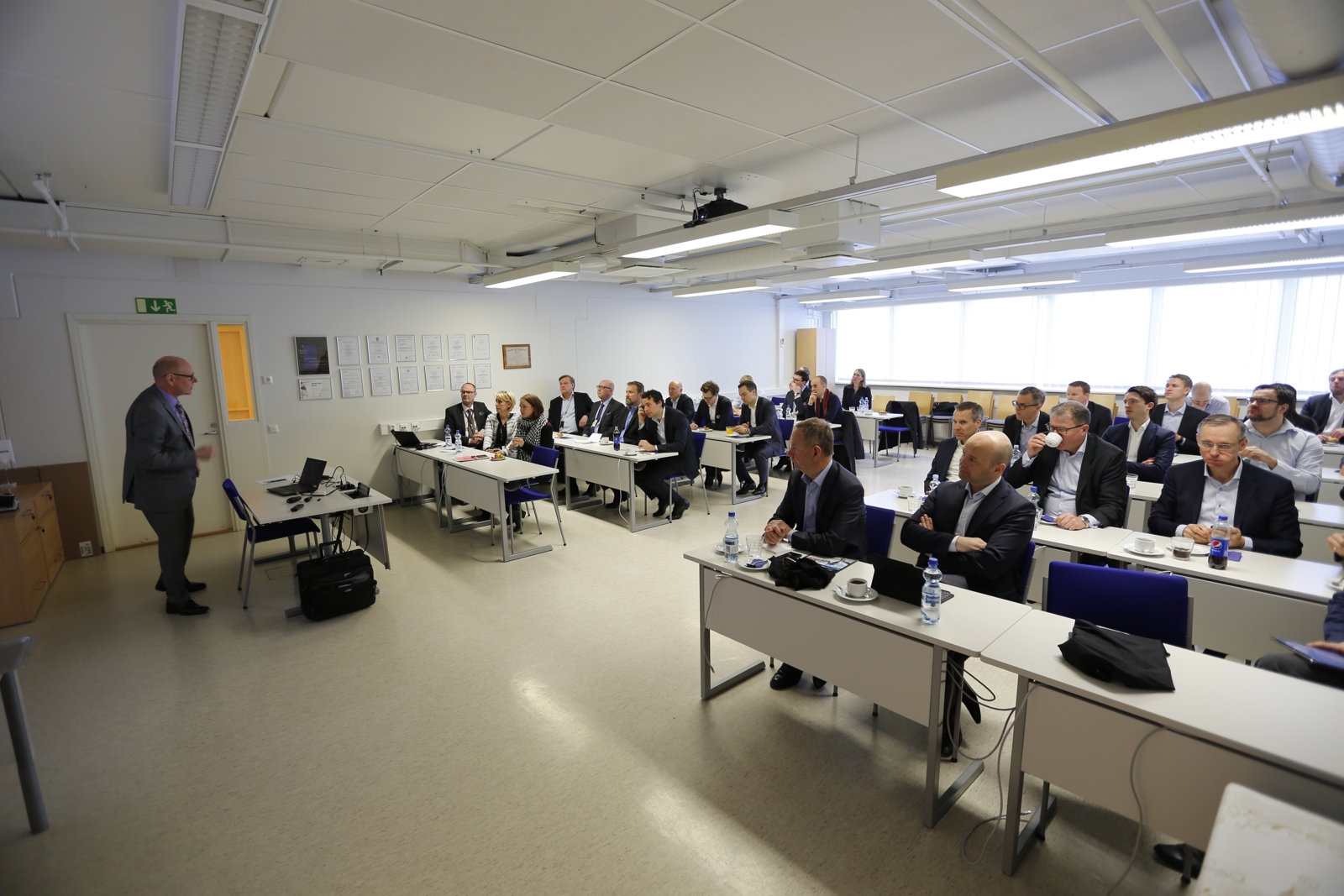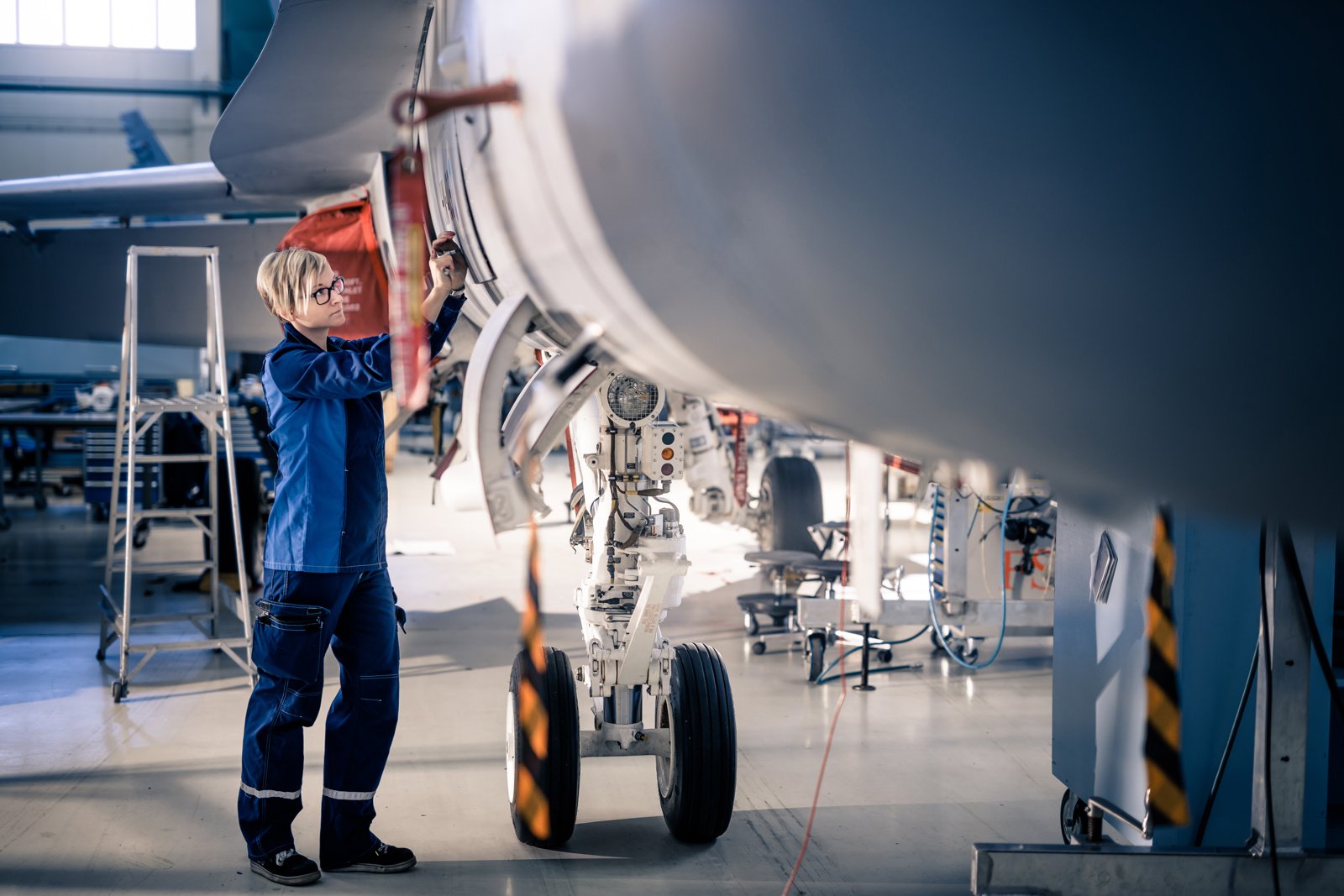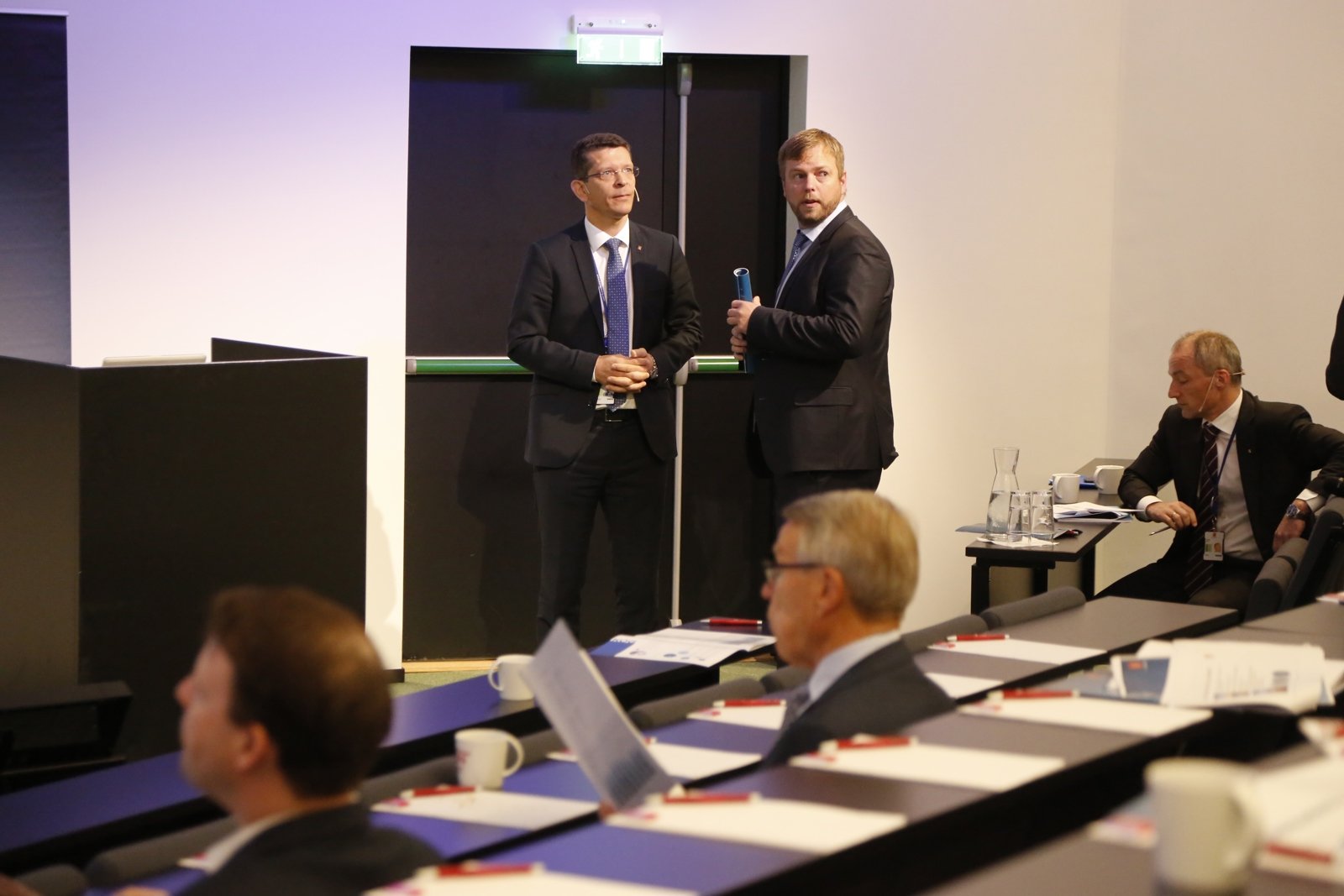
KONGSBERG spends a lot of time and resources explaining the company to analysts, brokers and investors. The reward is a high level of trust within the shareholder market, and accurate analyses.
-
Text:OVE RONNY HARALDSEN
-
Ove Ronny HaraldsenGroup Communication Manager
The silhouette of a fighter plane shooting towards the sky tells us that we are almost there. It’s an hour since the bus left Tampere in Finland. Deep inside the Finnish forests is an impressive facility belonging to the Finnish defence company Patria.
Over 20 representatives from brokerage firms, banks and shareholders emerge from the bus, invited here by Kongsberg Gruppen who, the year before, purchased 49.9 per cent of the shares in the company they will soon become better acquainted with.
–They actually have their own flight strip on the site, somebody comments as we stand at the entrance and show our Norwegian passports to the guard. The bus takes us further on to the site to a large hangar facility by the runway which is situated on an elevated area.
–All mobile phones and cameras must be left in the bus, warns Meeri Ahola who is coordinating the visit on behalf of Patria.
Travel and accommodation is paid by the participants themselves, while KONGSBERG and Patria have set up the programme. The group had already received an introductory presentation of the company during dinner with Patria’s senior management the previous evening. Now we will see for ourselves how the Patria business model works.

The Finnish Air Force land their F-18 fighter planes and Hawk training aircraft here at Patria’s facility in Halli for both heavy and light maintenance. Photo: Patria.
FINNISH MODEL FOR MAINTENANCE
Lassi Matikainen, President International Support Partnerships, welcomes us to Patria Aviation. This is one of four business areas in the company. Matikainen explains that the Finnish Air Force land their F-18 fighter planes and Hawk training aircraft here at the Halli facility for both heavy and light maintenance. But as Matikainen emphasises; maintenance of defence material in Finland has always been outsourced to civilians. The reason for this can be found in the past.
–After World War II, limitations were placed on how many employees the Finnish defence could have. Therefore, maintenance of defence material was carried out by civilians from the very beginning, Matikainen explains. However, in the event of a crisis or war, civilian employees would be included as part of the Finnish defence forces, he adds.
We were taken into the hangars where the fighter aircraft are dismantled and examined for cracks and stress damage in the fuselage. In addition, the Finnish F-18 aircraft have been modified here at the plant to withstand high G-force from their air-to-air roll. Currently, maintenance is one of the most important areas for Patria, not only in Finland, but also in Sweden, Norway and Denmark.

Currently, maintenance is one of the most important areas for Patria, not only in Finland, but also in Sweden, Norway and Denmark. Patria is present at a total of 13 bases in the three countries. Photo: Patria.
Patria is present at a total of 13 bases in the three countries. Outsourcing of maintenance tasks is spread over Europe. At the same time, nations join forces to purchase the same type of material in order to lower maintenance costs.
–We see a large market in the maintenance of defence material in the future. And we believe that collaboration with Kongsberg Gruppen can help us win further positions internationally, Lassi Matikainen tells the assembly after the tour in the hangar is over.
– AMONG THE BEST IN IR IN NORWAY
Travelling to locations like this in Finland is one of several tasks undertaken by Investor Relations (IR) in KONGSBERG. The department has two people and is directly accountable to the CFO. Important milestones throughout the year are four quarterly presentations, capital market day and production of the annual report. The department is responsible for sending stock market announcements and for promoting KONGSBERG stock to the international financial market.
Among the participants in Finland we find financial analyst Hans Erik Jacobsen from Swedbank who has been following the Kongsberg Gruppen for several years. Whether it is news from KONGSBERG, or something related to KONGSBERG’s competitors or political processes concerning the defence industry, he likes to call in on IR for comments. Ahead of the quarterly presentations, Jacobsen makes predictions regarding what KONGSBERG will earn, and uses IR as an active sparring partner around his assessments.
"Our experience of the quality of KONGSBERG’s Investor Relations is very good." Hans Erik Jacobsen, Swedbank
– Our experience of the quality of KONGSBERG’s Investor Relations is very good. We feel that IR personnel in KONGSBERG are very well informed, they have extensive in-depth knowledge and they are also very accessible. The IR work in Kongsberg Gruppen is on a par with the very best companies in Norway, explains Hans Erik Jacobsen.
- PROVIDES US WITH IN-DEPTH KNOWLEDGE
The visit to Halli continues with a trip to the Systems business area where Patria develops software solutions for command and control, intelligence and surveillance. The group demonstrated how advanced 3D map solutions are used in mission planning by the Finnish Air Force. Here in Halli, Patria manufactures composite parts for both civilian and military aircraft. The visit ends with a tour of the factory hall where Patria produces wing spoilers for the world’s largest passenger plane, the Airbus A380.
–The composite materials currently constitute up to 70 per cent of a modern aircraft, explains Petri Heppola, who heads one of the groups around the production hall. Hans Erik Jacobsen from Swedbank follows closely as Heppola explains the company’s strengths and market positions and the challenges that Patria anticipates in the future.
– You’ve also participated in other tours that Kongsberg has arranged. What do you get from participating in a trip like this?
–I t’s very important to come out and learn more about the products and see how things are produced. For us, it’s crucial to go out and visit companies in order to gain a deeper knowledge, both regarding how things are produced, and also how management views the prospects, says Hans Erik Jacobsen.
BEHIND THE QUARTERLY FIGURES
Vika Atrium two months later. Jan Erik Hoff and Nils Ole Krekling strike up a conversation with old acquaintances who have come to hear KONGSBERG present the results of the first quarter of 2017. The analysts have already made their qualified guesses on how KONGSBERG has performed these last three months. Now comes the answer. An answer with a lot of work behind it, involving a large number of people, explains Jan Erik Hoff who heads the IR work at KONGSBERG.

- As a company we manage our shareholders’ and creditors’ capital. They have the right to know that their investment is being managed well, says Jan Erik Hoff, who heads the IR work at KONGSBERG.
– The quarterly report is the last stop for the accounting figures and is the document that is published in connection with the presentation of the quarterly accounts of the Kongsberg Gruppen. This report is the result of many employees’ efforts. The profits are consolidated through the accounting systems and eventually end up as the consolidated KONGSBERG profit, he explains. In the final process, there is wide involvement both from within the group’s centre, and from the economists and managers in the business segments.
–We try to highlight the most important events that also explain the development of the group. The quality of what we publish, the actual figures - and also the text, is important. In addition to the actual production of text and figures, a lot of time is spent on quality assurance. IR – a source of capital – Investor Relations spends a lot of time and resources explaining the company to analysts, brokers and investors.
- What do you get in return for all this effort?
–Kongsberg Gruppen’s shareholders have invested capital to a greater or lesser degree in the company. In addition, there are many who lend us money. As a company we therefore manage our shareholders’ and creditors’ capital. They have the right to know that their investment is being managed well. Both equity (shares) and the debt market are also markets where one can “obtain” money for investing and other purposes, explains Jan Erik Hoff.
KONGSBERG has traditionally used the debt market for this, but in certain situations, the equity market is also a very efficient market that can provide substantial capital in a relatively short period of time.

The presentation for the quarter is also a meeting opportunity between journalists and the management of KONGSBERG. The group’s communications department isresponsible for publishing press releases and reports, as well as for press management.
–It is therefore important for us to be visible, both in order to satisfy our existing stakeholders, but also to attract new parties so as to consistently have an investor base that believes in what we are doing and is willing to invest. Kongsberg Gruppen is a recognised player in these markets and enjoys high confidence in both the equity and debt market, concludes Jan Erik Hoff, Group Vice President Investor Relations.

